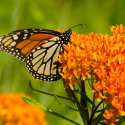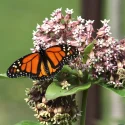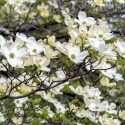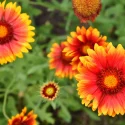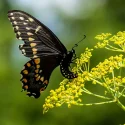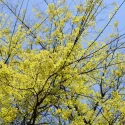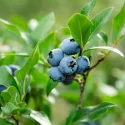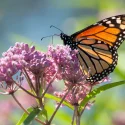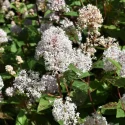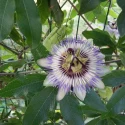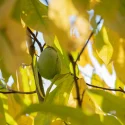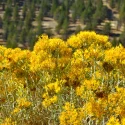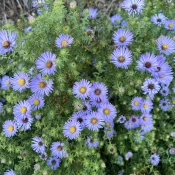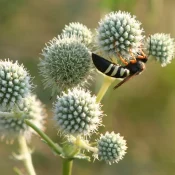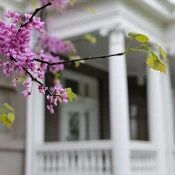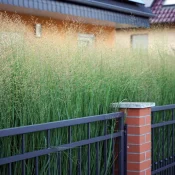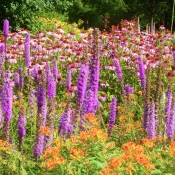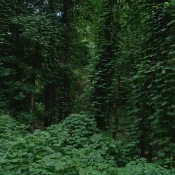Native Asters: A Beginner’s Guide
Just when it seems like the garden is winding down, these native beauties burst into bloom. There are 100+ asters native to North America, in colors from white to blue to purple. Asters are essential for pollinators, offering vital late summer and fall nectar. Beginner-friendly, they thrive in various sunlight conditions—some even enjoy the shade. Every garden deserves at least three species of asters. Scroll below to find your favorites.
- Full Sun, Part Sun, Full Shade
- Height depends on species
- Fall flowers
- Pollinator lifeline
A single aster can have HUNDREDS of flowers
Let’s dig deeper into why asters are so special, including tips on planting and the best varieties to enhance your garden.
What are the benefits of planting native asters?
Asters are very important flowers because they bloom when many other flowers have gone to seed—at the end of summer and into the fall.
Their flowers are crucial food for pollinators, including Monarchs migrating back to Mexico. Planting asters ensures that bees, butterflies, and other pollinators have food while migrating or preparing for hibernation. If you are planting a pollinator garden, include native asters.
Other benefits of planting native asters include:
- Depending on the type, they can be shade or part-shade lovers
- Low maintenance: no fertilizer or special needs are required for native aster to thrive
- Perennials: they will come back year after year. Once you plant them and they are happily established, you can enjoy them in your yard for years.
- Time savers: Native asters save time and money compared to lawn care. Once established, they thrive on rainfall alone, needing extra water only during intense droughts.
And one more benefit to planting native asters 🦋
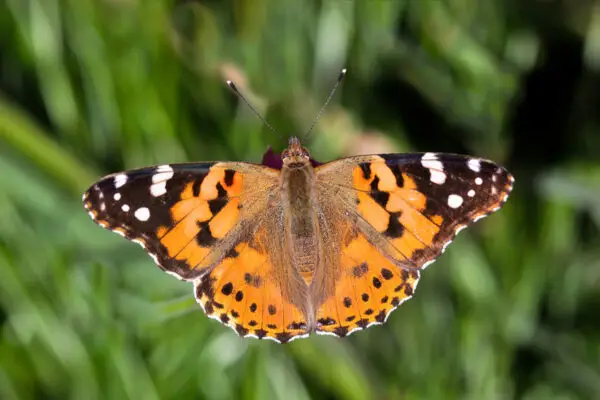
Native asters are the host plants for many butterflies
New England and New York Asters are host plants to Pearly Crescentspot, Crescentspot, and Silvery Crescentspot butterflies. Simply put, without their native host plants, these butterflies would not exist!
What is a host plant?
A host plant is a specific plant that a bug, butterfly, or caterpillar eats, lives on, or lays its eggs on.
To help keep your asters covered in butterflies and pollinators, we have a tip:
No pesticides or herbicides
Avoid using pesticides or herbicides near aster plants, as they can harm the butterflies and pollinators that visit the flowers. Keeping our gardens free of pesticides and herbicides helps invite pollinators and birds into our spaces.
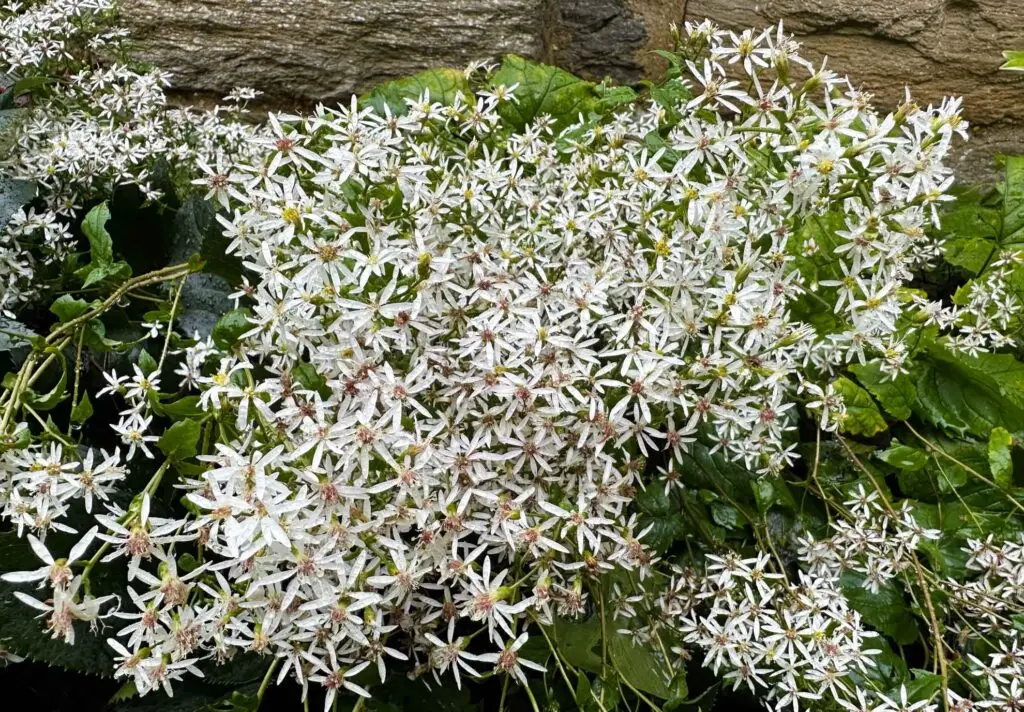
Types of native aster
100+ asters are native to North America. Here are six species easily found at local native plant nurseries:
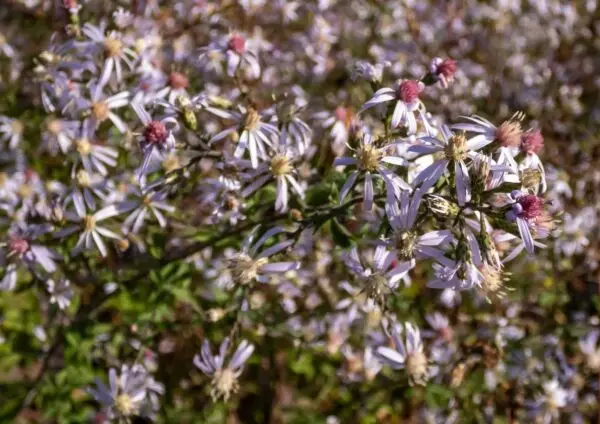
Blue Wood Aster
Symphyotrichum cordifolium
Blue Wood Asters (sometimes also called Heart-leafed Aster) are named after its heart-shaped leaves. (If you like heart-shaped leaves, also plant a Redbud!) Its flowers are a very pale blueish-purple. Blue Wood Asters prefer partial-sun but can also grow in part shade or full sun (perfect for beginner gardeners!)
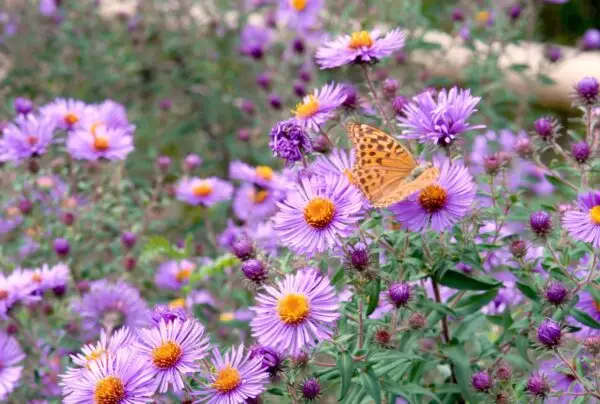
New England Aster
Symphyotrichum novae-angliae
New England Asters are important food for migrating Monarch butterflies. New England Asters cover themselves in purple flowers in the late summer/fall. A single plant can have hundreds of small purple flowers, which the pollinators dive into. New England Asters are super easy to grow: they like full sun to light shade. New England Asters can get tall (5 feet at times); cut them in July to keep them smaller or stake them if they need support.
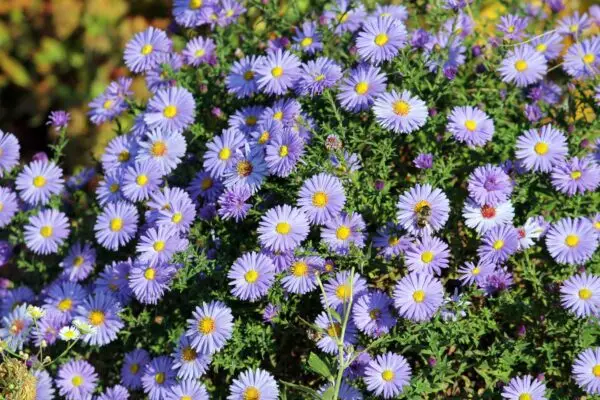
New York Aster
Symphyotrichum Novae-belgii
New York Asters offer piles of blue-purple flowers in the late-summer/fall. Whether you’re planting in New York, or anywhere in New England or the Midwest, these will happily bloom. New York Asters are perfect for wetter gardens: they like moist to wet soil.
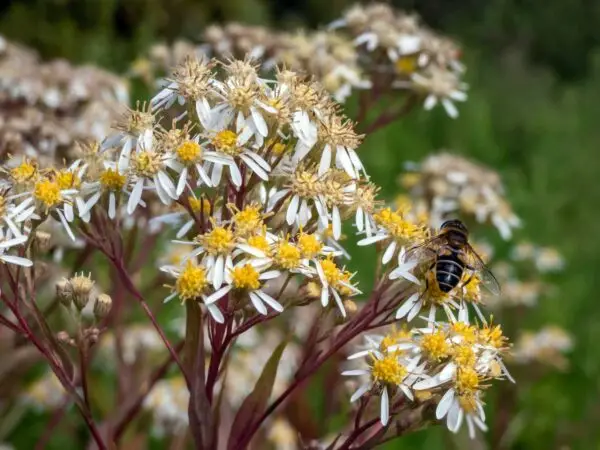
Parasol Aster
Symphyotrichum umbellatus
Parasol Asters place their flowers in clumps atop tall stems (hence their common name). Parasol Asters like a wide range of sun—full sun to part shade is fine!
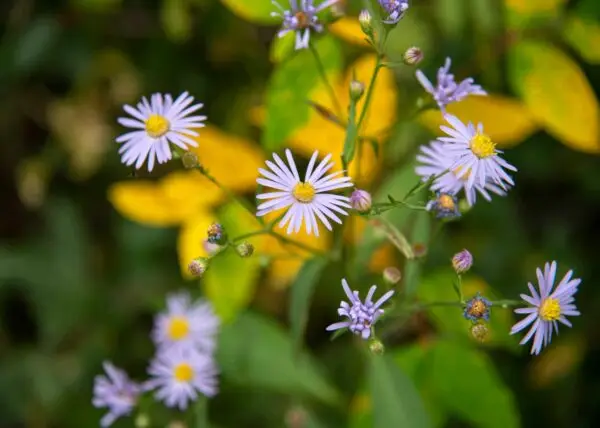
Smooth American Aster
Symphyotrichum laeve
Uli Lorimer, director of the Native Plant Trust, introduces this plant beautifully: “this aster belongs in every pollinator garden, butterfly garden, or meadow planting. I have seen the flowers covered in monarch butterflies, skippers, and clouded sulfurs, to name just a few.” (from Northeast Native Plant Primer.) Full sun to part sun.
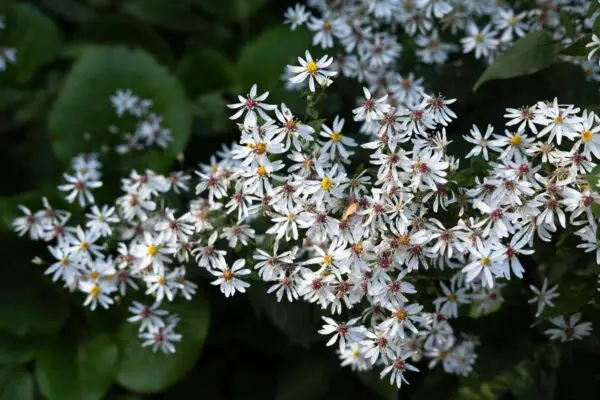
White Wood Aster
Eurybia divaricata
Do you have a shady spot? White Wood Asters are for you. They are not woody—their name comes from their native habitat in woodland forests. White Wood Asters like dry, shady places.
What about the other ~100 asters?
There are dozens of other native aster species that are less commonly found in plant nurseries. (The Missouri Department of Conservation lists 24 species in Missouri alone.) Click or tap below to find 10+ species—including the ones we just met—organized by region.)
10+ Native Species of Asters
North American native species of aster include:
| Common Name | Latin Name | Native Region | Flower Color |
|---|---|---|---|
| Northeastern United States | |||
| New England Aster | Symphyotrichum novae-angliae | Northeastern U.S. | Purple to Pink |
| White Wood Aster | Eurybia divaricata | Appalachian Mountains | White |
| Blue Wood Aster | Symphyotrichum cordifolium | Northeastern U.S. | Light Blue to Violet |
| Southeastern United States | |||
| Georgia Aster | Symphyotrichum georgianum | Georgia, Alabama, Florida | Deep Purple |
| Midwestern United States | |||
| Smooth Blue Aster | Symphyotrichum laeve | Midwestern U.S. | Blue to Purple |
| Skyblue Aster | Symphyotrichum oolentangiense | Midwestern U.S. | Sky Blue |
| Aromatic Aster | Symphyotrichum oblongifolium | Midwestern, Mid-Atlantic, and parts of Northeastern U.S. | Blue to Purple |
| Western United States | |||
| Pacific Aster | Symphyotrichum chilense | Western U.S. | Lavender |
| Western Aster | Symphyotrichum ascendens | Western U.S. | Violet to Nearly White |
| Arctic Aster | Eurybia sibirica | Alaska, Northwestern Canada | Purple |
| Southwestern United States | |||
| Bigelow’s Aster | Machaeranthera bigelovii | Southwestern U.S. | Purple |
Now that we’ve met a pile of native aster species let’s answer a few FAQs about them.
FAQs
Where did the name aster come from?
The name aster translates into star. Asters get their name from the Greek word ‘ἄστρον,’ which means “a celestial body (typically stars and planets).”
It’s a wonderful tribute to their star-like flowers and a beautiful reminder that the small things in our gardens can remind us of unfathomably large things—like the universe itself.
Should I cut native asters?
Some native asters can grow quite tall—3-6 feet!—and sometimes tumble over themselves or crowd out other plants when covered in blooms.
To keep larger species smaller, cut the top of the plant off in mid-summer—right around July 4th—before they bloom. Don’t worry about the severe haircut: the plant will then spend time making flowers instead of stems and keep the size much more manageable.
If you forget to give them a July 4th trim, don’t worry! Just grab some stakes and give them something to lean on if they get too tall in the fall.
What are the best asters for wet areas?
New York Aster thrives in wetter gardens. Explore our Best Native Plants for Rain Gardens if you’re planning for a water-logged area.
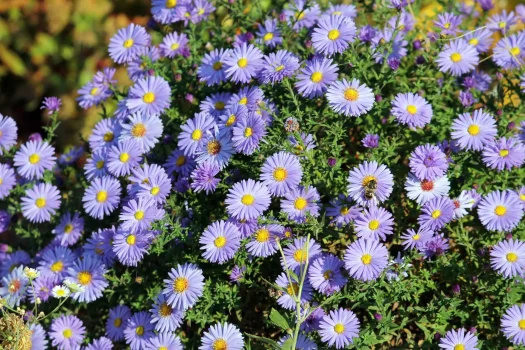
What are the best asters for shade?
White Wood Aster is great for shade.
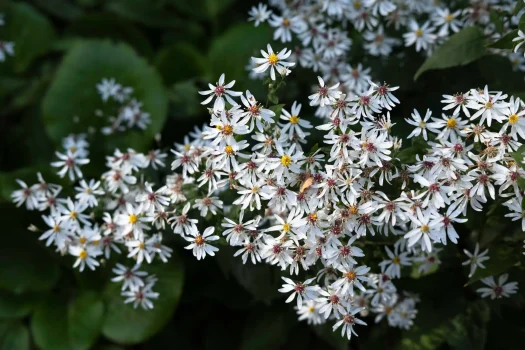
What is the difference between asters, daisies, and mums?
As you look at pictures of asters, you might be thinking, “Hmm…asters are tiny daisies, right?” Or perhaps their piles of flowers and fall blooms remind you of chrysanthemums (sometimes called ‘mums’)?
However, only asters have species native to North America.
Here is a beginner-friendly overview of their differences:
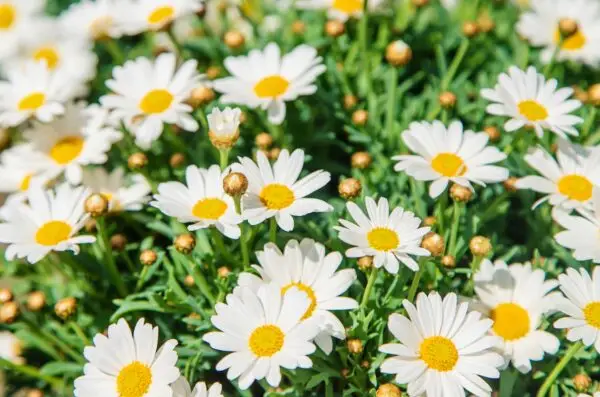
Daisies
Normally when we think of daisies, we’re thinking of the Shasta Daisy or Oxeye Daisy, which has a yellow center and white flowers. These daisy species are native to Asia and Europe.
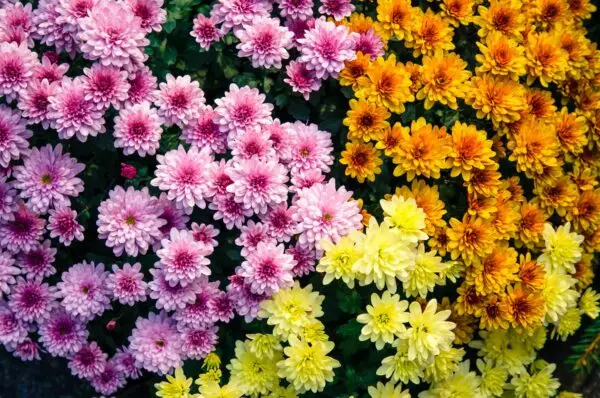
‘Mums’
‘Mum’ is short for Chrysanthemum; these flowers are native to Asia and Europe. In the fall, you’ll often see bright tubs of mums outside grocery stores and plant nurseries.
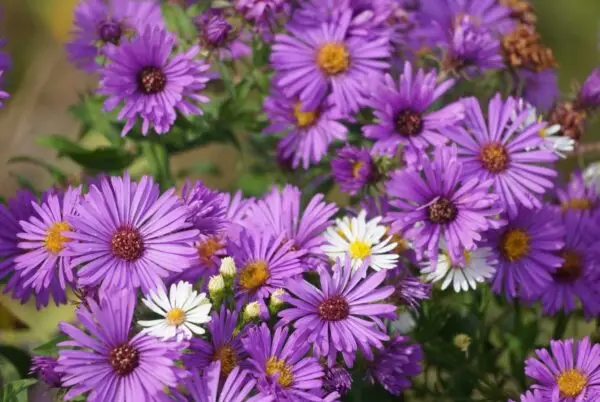
Asters
Asters have delicate daisy-like flowers in the fall. There are 120 varieties of Asters native to North America. Scroll above to find different types, colors, and shade-loving species.
Where can I find native asters?
Finding native plants can sometimes be challenging. Big box stores and even some independent nurseries do not carry many native plants. But there are many places to find native asters, if you know where to look!
Here are four reliable resources for finding native asters. (Our extensive list of over 100 native plant nurseries is especially useful!)
Where can I find seeds and plants?
Finding native plants can be challenging (we partly blame Marie Antoinette.) To make it easier, we’ve assembled four sourcing ideas.
Native Nursery List
300+ native nurseries makes finding one a breeze
Online Native Plant Sellers
We've included 100+ online resources to help
Society Plant Sales
Every state has a native plant society; find yours
Online Communities
Local Facebook groups are a great plant source
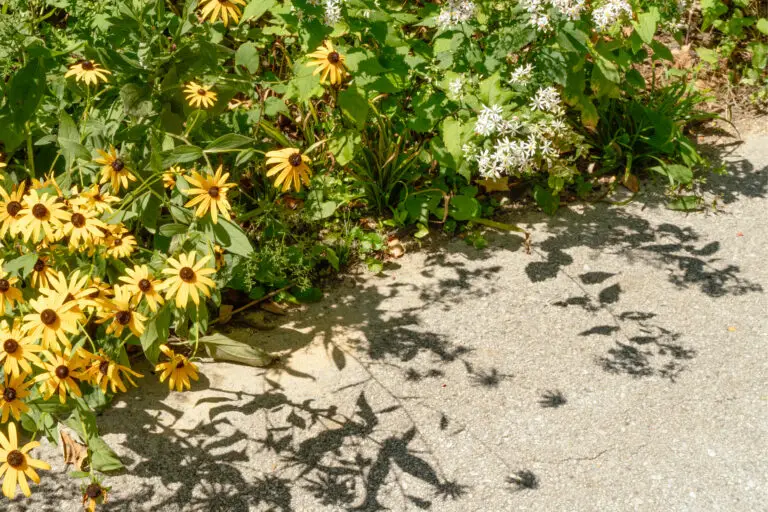
What pairs well with native asters?
Asters look great alongside other plants that flower at different times, so pollinators always have something to eat.
For a stellar fall garden, plant asters alongside other fall-blooming flowers with yellows, oranges, and reds. As Stephanie Cohen writes for the Brooklyn Botanic Garden’s blog: “[Asters] primarily blue-violet flower tones work in cool, subtle contrast to the fiery fall landscape at large.” Some ideas include:
Other natives for the fall
Natives for the spring and summer
To sum it up: native asters are necessary and gorgeous additions to any Northeast, Mid-Atlantic, Midwest, or Southern garden. They offer pollinators food at the end of the summer and help give gardens a pop of color as we head into fall. Native asters are exceptionally easy to plant and come back year after year. Plant a few today to give pollinators something to snack on alongside something bright in the fall. Happy planting!
Sources
- Harris, Marjorie. Botanica North America: The Illustrated Guide to Our Native Plants, Their Botany, History, and the Way They Have Shaped Our World. (2003), 82-84.
- Johnson, Lorraine. 100 Easy-to-Grow Native Plants for American Gardens in Temperate Zones. (1999), 76, 122.
- Lorimer, Uli. The Northeast Native Plant Primer. (2022), 178-179.
- Brooklyn Botanic Garden, Asters.
- Chicago Botanic Garden, Native Asters Shine in the Garden
- Minnesota State Horticultural Society, Native Aster Species for Northern Gardens
- Piedmont Master Gardeners, Color and Life in the Fall Garden
- Missouri Department of Conservation. “New World Asters (American Asters),” n.d. https://mdc.mo.gov/discover-nature/field-guide/new-world-asters-american-asters.
- Latin Language Stack Exchange. “The Difference Between Ᾰ̓́Στρον (Ástron) and Ἀστήρ (Astḗr) in Ancient Greek.”












